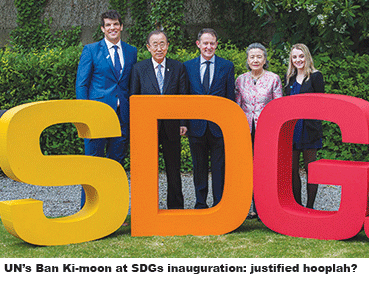Global Development: SDGs replace MDGs
 The “largest gathering ever of world leaders”; a “step-change” in aid; a “massive step forward for humanity”: the UN meeting held on September 25 had politicians, donors and aid workers reaching for superlatives (as well as jargon). Prime ministers, presidents and the Pope in New York unveiled the Sustainable Development Goals (SDGs) that are supposed to shape aid and development for the next 15 years. Is the hoopla justified?
The “largest gathering ever of world leaders”; a “step-change” in aid; a “massive step forward for humanity”: the UN meeting held on September 25 had politicians, donors and aid workers reaching for superlatives (as well as jargon). Prime ministers, presidents and the Pope in New York unveiled the Sustainable Development Goals (SDGs) that are supposed to shape aid and development for the next 15 years. Is the hoopla justified?
Most of SDGs’ predecessor, the Millennium Development Goals (MDGs), have been met, largely because of progress in China and India. But there were just eight of them, focused on cutting extreme poverty and improving healthcare and education, all clearly defined. By contrast, there are 17 SDGs and a whopping 169 “associated targets”, covering world peace, the environment, gender equality and much, much more. Many are impossible to measure. They are “higgledy-piggledy”, agrees Lord (Mark) Malloch-Brown, who helped write the MDGs. A tighter focus and more precise definitions might have been wise.
Even so, the SDGs are part of an important shift in thinking about development that is making it both more ambitious and more realistic.
Poor-country governments and rich-world aid lobbies have become less hostile in recent years to the idea that free markets and big business can help cut poverty. Multinationals were wary when the MDGs were unveiled, says Malloch-Brown; now many are on board. And some rich-as-Croesus philanthropists, together with a bevy of market-friendly think-tanks, have started to monitor and measure the results of aid spending, and to search for ways to make it more effective. “The MDGs got everyone to face the same direction,” says Andrew Mitchell, who ran Britain’s aid-giving department from 2010-2012.
Pre-eminent among the big spenders is Bill Gates, the Microsoft magnate, whose foundation has dished out more than $31 billion (Rs.201,500 crore) since 2000. George Soros, a Hungarian-born American financier, and his Open Society Foundations argue for transparency in aid, budgets and contracts. The Gatsby Charitable Foundation, started by Lord (David) Sainsbury, a British retailer, advises African governments and business on improving supply chains. Another Briton, Sir Christopher Hohn, a financier, has spent more than $1.5 billion (Rs.9,783 crore) since 2006 via his Children’s Investment Fund Foundation (CIFF) on spreading the crucial message that improving young children’s health leads to big benefits later in life.
Soros has sought to make governments and firms open about their philanthropy dealings. In 2002, his foundation helped set up Publish What You Pay, now a global coalition of 800-plus independent watchdogs, and in 2013 it launched a Transparency Champions Challenge. Another monitor with clout is the Open Budget Index, launched in 2006 by the Centre on Budget and Policy Priorities, a Washington think-tank. The Berlin-based scrutineer, Transparency International, founded in 1993 by Peter Eigen, a former World Banker disgusted by the corruption he saw in east Africa, has become a strong force for uncovering corruption, including in the aid world.
Leading the fight against graft in mining, oil and gas is the Extractive Industries Transparency Initiative. Under Clare Short, a former British minister for aid, it has steadily gained momentum, with 48 governments (22 in Africa) and 90-odd big companies promising to expose payments and revenue to public scrutiny. The British and American governments have signed up, hoping France and Germany will follow, though Brazil, China, India and Russia seem unlikely to do so any time soon. Ellen Johnson Sirleaf, Liberia’s president, is a fan. Even governments in Congo-Brazzaville and the Democratic Republic of Congo, both bywords for corruption, have had to become a bit more accountable (admittedly from very modest beginnings). “They just can’t steal with same impunity as before,” says one of the initiative’s activists.
As the SDGs proliferate, donors are putting greater emphasis on measuring results and collecting data. They need data to be more disaggregated and to know where the poor are concentrated, as well as their ages, how they live and what sort of work they do. Advances in technology make this easier. Satellites can more precisely determine where forests are thinning, for example, or where crops are thriving or wilting. Among the SDG targets is one that calls for all births to be registered so that all children have legal identities, and their progress can be tracked. What matters most is “measuring need and measuring impact,” says Michael Anderson, who runs CIFF and was previously Cameron’s special envoy for the UN’s development goals. Yet, he adds, of the 193 countries which have signed up to the SDGs’ nutrition targets only 74 have enough data to assess whether they’re on track to meet them.














Add comment